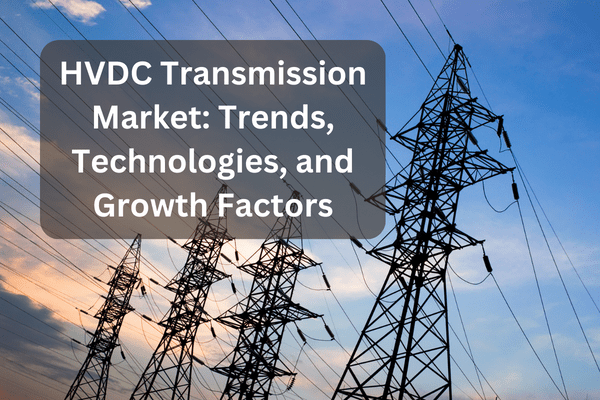Are you curious about the latest trends, technologies, and growth factors in the HVDC transmission market? If so, you’ve come to the right place. In this blog post, we will study in detail about the exciting world of high-voltage direct current (HVDC) transmission and explore its market forecast, future prospects, and economic impact.
Whether you’re a technology enthusiast, an industry professional, or simply interested in the future of energy transmission, this article will provide you with valuable insights and a comprehensive understanding of the HVDC transmission.
Factors Driving the Growth of the HVDC Transmission Market
Several factors contribute to the growth of the HVDC transmission market. Firstly, there is an increasing demand for clean and sustainable energy. HVDC transmission technologies enable the integration of renewable energy sources, such as offshore wind farms, into the main transmission grids.
With the global focus on reducing carbon emissions and transitioning to a low-carbon economy, the demand for HVDC transmission systems is expected to rise. Secondly, government policies and regulations play a significant role in driving the growth of the market.
Countries like Germany, Spain, Belgium, and France have implemented policies that support the transition to a low-carbon energy system, creating a favorable environment for the adoption of HVDC transmission technologies.
Lastly, the increasing need for interconnecting grids and transmitting power over long distances contributes to the growth of the HVDC transmission market. HVDC systems offer efficient and reliable long-distance power transmission capabilities, making them ideal for interconnecting grids and enabling power transfer between different geographic regions.
HVDC Transmission Technologies
HVDC transmission technologies play a crucial role in the growth of the market. There are two primary types of HVDC technologies: HVDC Light® (VSC) and HVDC Classic (LCC).
- HVDC Light® is a voltage source converter (VSC)-based HVDC technology that offers several environmental benefits. It features compact converter stations and invisible transmission, making it suitable for applications where visual impact is a concern. HVDC Light® technology is commonly used for city center infeed, connecting remote generation and loads, and offshore wind connections.
- On the other hand, HVDC Classic technology is mainly used for the transmission of bulk power and AC system interconnections. It provides a reliable and efficient means of transmitting high power over long distances. HVDC Classic technology is utilized in applications such as interconnecting grids, extensions, upgrades, retrofits, and overhead transmission lines.
These HVDC transmission technologies are essential for enabling efficient and reliable power transmission over long distances for various applications. Whether it’s connecting remote generation and loads in city centers or interconnecting grids across different geographic regions, HVDC Light® and HVDC Classic technologies provide the necessary infrastructure for these power transmission needs.
The compact and invisible transmission capabilities of HVDC Light® make it suitable for applications where visual impact is a concern, while the reliable and efficient transmission capabilities of HVDC Classic make it ideal for bulk power transmission and AC system interconnections. With these technologies, the HVDC transmission market can meet the demand for long-distance power transmission while minimizing power loss and maximizing efficiency.
HVDC Transmission Market Trends
HVDC (High Voltage Direct Current) transmission market has been witnessing several notable trends:
Renewable Energy Integration: HVDC technology is increasingly being used to integrate renewable energy sources, such as offshore wind farms, into existing power grids. HVDC facilitates the efficient transmission of power over long distances, making it ideal for connecting remote renewable energy generation sites to population centers.
Grid Modernization Initiatives: Many countries are investing in grid modernization projects to improve the efficiency, reliability, and flexibility of their power transmission infrastructure. HVDC systems play a crucial role in these initiatives by enabling the development of smart grids and enhancing grid stability.
Intercontinental Power Transmission: HVDC technology enables the transmission of electricity over extremely long distances with minimal losses. This capability is driving the development of intercontinental HVDC transmission projects, such as submarine cables connecting different regions or countries.
Urbanization and Industrialization: Rapid urbanization and industrialization in emerging economies are driving the demand for reliable and efficient power transmission solutions. HVDC technology offers advantages in terms of higher power transmission capacity and lower transmission losses compared to traditional AC (Alternating Current) transmission systems.
Technological Advancements: Ongoing advancements in HVDC technology, including improvements in converter technology, control systems, and insulation materials, are enhancing the performance and efficiency of HVDC transmission systems. These advancements are also driving down costs, making HVDC more competitive with AC transmission alternatives.
Energy Storage Integration: HVDC systems are being increasingly coupled with energy storage technologies, such as batteries and pumped hydro storage, to provide grid stabilization services, enhance renewable energy integration, and optimize energy flow within the grid.
Conclusion:
In conclusion, the HVDC transmission market is experiencing significant growth due to various market trends, advancements in HVDC technologies, and key growth factors. With the increasing demand for renewable energy sources, the need for efficient transmission systems like HVDC is becoming more crucial.
A market research company plays an important role in today’s world of business by providing invaluable insights into market trends, consumer behavior, and competitive analysis. These companies employ a variety of methodologies, from surveys and interviews to data analysis and trend forecasting, to help businesses make informed decisions.


